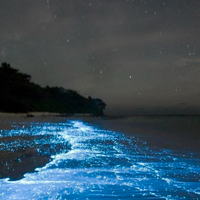Bioluminescence: the ocean’s shining light
Curtis Champion, 23 Oct 2018.
Bioluminescence is undoubtedly a wonder of the natural world that’s capable of captivating the imaginations of those who witness the phenomenon, including the father of evolution Charles Darwin whose first notebook entry while aboard the famous Beagle voyage remarked that:
“The sea was luminous in specks and in the wake of the vessel, of a uniform slightly milky colour. When the water was put into a bottle, it gave out sparks…”
Given the awe-inspiring visuals that bioluminescent marine critters provide, it’s worth diving a little deeper to understand how and why these species glow.
Bioluminescence is the production and emission of light by organisms. The phenomenon is triggered by specialist cells that are capable of converting chemical energy to light energy. Species that are capable of producing bioluminescence might be more abundant than you think. For example, it’s thought that about 75% of deep-sea creatures are capable of producing their own light and bioluminescence is known to have evolved at least 40 times on land and in the ocean.
The purposes of bioluminescence in marine animals are diverse and fascinating, ranging from attraction to communication and defence. For example, some squid use bioluminescent liquid mixtures in the same way as many squid use ink. A cloud of luminescent material is expelled, distracting or repelling a potential predator, while the squid escapes to safety in a cloud of colour.
Perhaps one of the most ingenious ways that bioluminescence is utilised for defence involves attracting predators to scare off other species that may be out to cause you harm. This is the case for tiny, single celled, dinoflagellates (zooplankton) that become bioluminescent in response to changes in water pressure caused by waves, boat wake or the feeding of nearby predators. This group of marine critters utilise bioluminescence at night to brighten the surrounding environment so that visual predators are attracted to the scene, which subsequently keeps their own would-be predators at bay. These are the same animals that cause the shoreline of beaches and bays to light up at night, due to ripples and waves creating changes in water pressure in these environments.
Who would’ve thought that the evolution of a bioluminescent response that helps plankton avoid being eaten could provide photographers and beachcombers with such a stunning visual spectacle?












